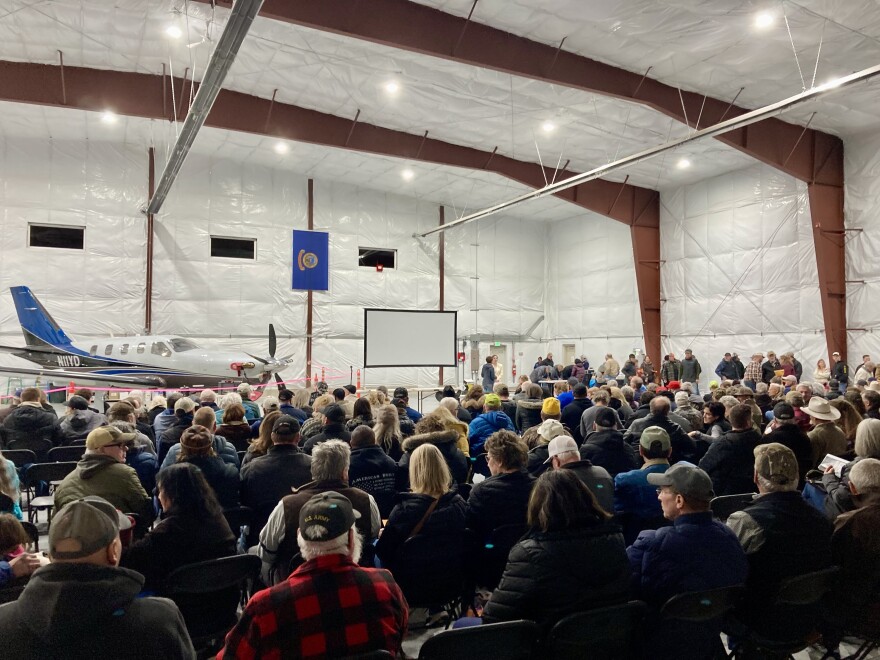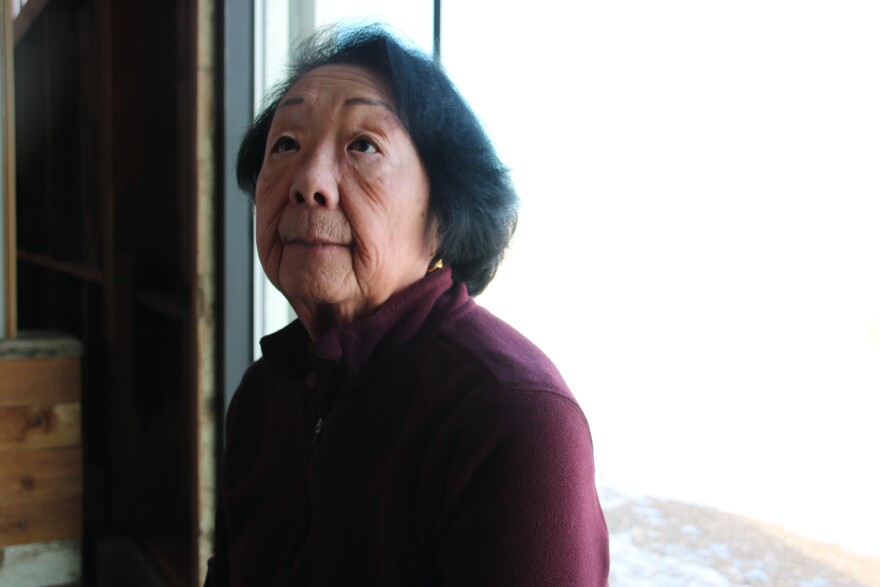Karen Misako Hirai Olen spent the first year and a half of her life imprisoned.
She was born at the Minidoka War Relocation Center. Her Japanese American parents were sent there after being forcibly removed from their Seattle-area homes, and were among the 13,000 people the U.S. government incarcerated there during World War II.
On a biting cold day earlier this year, Hirai Olen, a Minidoka survivor, looked out at the high-desert landscape in Jerome County, surrounding what is now the Minidoka National Historic Site, and worried she’d soon see wind turbines scattered on the horizon.
“They wouldn't build this outside of Arlington National Cemetery. They wouldn't build this on the Washington Mall,” she said. “And to me, this site is just as sacred.”

The turbines would be part of a big wind farm being proposed on neighboring Bureau of Land Management land by Magic Valley Energy, a subsidiary of New York-based LS Power. It would include up to 400 turbines across 76,000 acres and would be one of the largest wind projects in the country.
The closest turbines could be under two miles from the Minidoka National Historic Site’s visitor center.
To the nonprofit Friends of Minidoka, that would fundamentally change the experience of going to the site and imagining the hardships of the incarcerated. Survivors of Minidoka and their descendants make an annual pilgrimage there in the summer.
“The proposed Lava Ridge project minimizes the trauma, loss and humiliation suffered by American citizens based solely on racial discrimination of their ancestry,” said Robyn Achilles, the executive director of the organization.
Though she doesn’t remember being at Minidoka herself, Hirai Olen said the trauma of those incarcerated there – in her family, that includes 14 aunts and uncles, along with her parents – has been passed down generations. Now she feels it's her duty to protect the history.
“Just based on basic human rights, I have to oppose this,” said Hirai Olen, who lives in Twin Falls.

Many with connections to Minidoka who also oppose the project said they otherwise support the Biden Administration's goal to source 100% clean electricity by 2035 to combat climate change. There’s also a specific target to permit 25 gigawatts of renewable energy on public land by 2025.
Currently, the U.S. gets a lot of oil and gas from federal land, but comparatively little renewable energy.
Secretary of the Interior Deb Haaland touted the administration’s progress at a Western Governors Association meeting last fall.
“A sustainable, clean energy economy isn't just an idea,” she said. “It’s here. It’s happening.”
But experts say a lot more wind and solar is needed to meet such thresholds and that the building needs to happen quickly.
Magic Valley Energy’s pitch is that Idaho could be a renewable energy exporter to states with ambitious goals and more people, like California or Nevada, though an official buyer of the power hasn’t been announced. The one gigawatt of power generated by Lava Ridge could supply upwards of 300,000 homes.
The company also said construction will pump $500 million into the local economy, and that once the turbines are spinning, they’ll generate $4 million a year in local taxes.
But a growing number of locals feel like there’s little in this plan for them.
Cows and turbines
The landscape of the proposed wind farm site is dominated by sagebrush and cheatgrass with outcroppings of lava rock. John Arkoosh said there’s also plenty of good grazing for cattle. He’s one of several ranchers who lease this land from the federal Bureau of Land Management.
“There's seven different ranches that run on this allotment alone,” he said. “My own, there's four generations, four families that depend on this area for our livelihood.”
The power company has several ideas for how to mitigate impacts to ranches during construction. That could include paying one producer to move all their cows out of the area for a couple of years so the rest can stay. It also said the cows and turbines can coexist.
But Arkoosh said he’s resolved to not take any deals. He wants the project canceled, and he helped found a group to do just that: Stop Lava Ridge. Its Facebook page has more than 3,000 members.
“We truly don’t believe this is good for Idaho,” Arkoosh said.

Among researchers and policy experts, there’s a growing perception that choosing locations for renewable projects and getting them approved could be one of the central challenges in the clean energy transition.
For one, a lot of land is needed. But, a study from The Nature Conservancy found the U.S. could meet its clean energy targets while still being more selective in where to place the infrastructure to protect wildlife, for example.
Failing to be intentional with the planning, the organization said, could both threaten biodiversity and cultural resources, but could also risk projects getting delayed because of those conflicts.
Jungwoo Chun is a lecturer with MIT’s urban planning department. He’s studied opposition to renewable energy and said treating community concerns as simply a ‘not-in-my-backyard’ problem is a mistake.
Most projects on BLM land will likely need environmental impact statement reviews, which involve many opportunities for local communities to share feedback, including concerns.
In a study published last year in the journal "Energy Policy", Chun’s team found local pushback frequently delays or cancels projects, or gets them tied up in lawsuits, so he said proponents should take it seriously.
“I'm sure many of those people who are actually the policymakers probably weren't even aware that such local opposition could actually be detrimental to their plans,” he said.
His team at MIT is developing a conflict mediation project for renewable energy siting to try to bring stakeholders together early in the process.
Still, Eric Lantz, a wind energy analyst at the National Renewable Energy Laboratory, said each permitting decision has downstream implications.
“If we don’t put it here, where does the next one go? And is that actually a preferable location?” he said, not speaking about Lava Ridge in particular.
He said not choosing the windiest spots -- or the sunniest for solar -- could necessitate more development to meet energy goals and demand, and that that’ll be more costly.
“Do you care about what happens to us?”
One recent evening, Arkoosh’s group invited those wanting to stop the project to a private airport hangar. About 300 people gathered, including Hirai Olen and others from Friends of Minidoka. Members from the local BLM office showed up, too, to answer questions.
Several revealed a sense of desperation, like one exchange with Twin Falls District Manager Mike Courtney.
“I mean, my God, did you grow up here?” shouted a member of the audience, Randy, who would only give his first name.
“I did,” replied Courtney, from the front of the room.
“Do you care about what happens to us?”
“I do.”
“My God, I don’t believe you,” Randy said.
“That’s why I’m here,” Courtney said.

The BLM says it’s required to analyze viable proposals it receives. That’s what it’s doing now. It released a draft environmental impact statement on Lava Ridge last month.
In the report, the agency indicated it prefers two alternatives to Magic Valley Energy’s original proposal, which involve a smaller number of total turbines and would place them farther from the Minidoka National Historic Site.
Still, county commissioners also oppose the wind farm and Gov. Brad Little and members of the federal delegation said the project needs big changes to win their support.
The BLM is taking public comments through March 21 and a final result on the project could be out in the fall.
But this likely won’t be the only contentious renewable energy siting decision this local BLM office has to make. Seven more applications for projects on public land are lined up behind this one in the Magic Valley region alone.
Find reporter Rachel Cohen on Twitter @racheld_cohen
Copyright 2023 Boise State Public Radio



